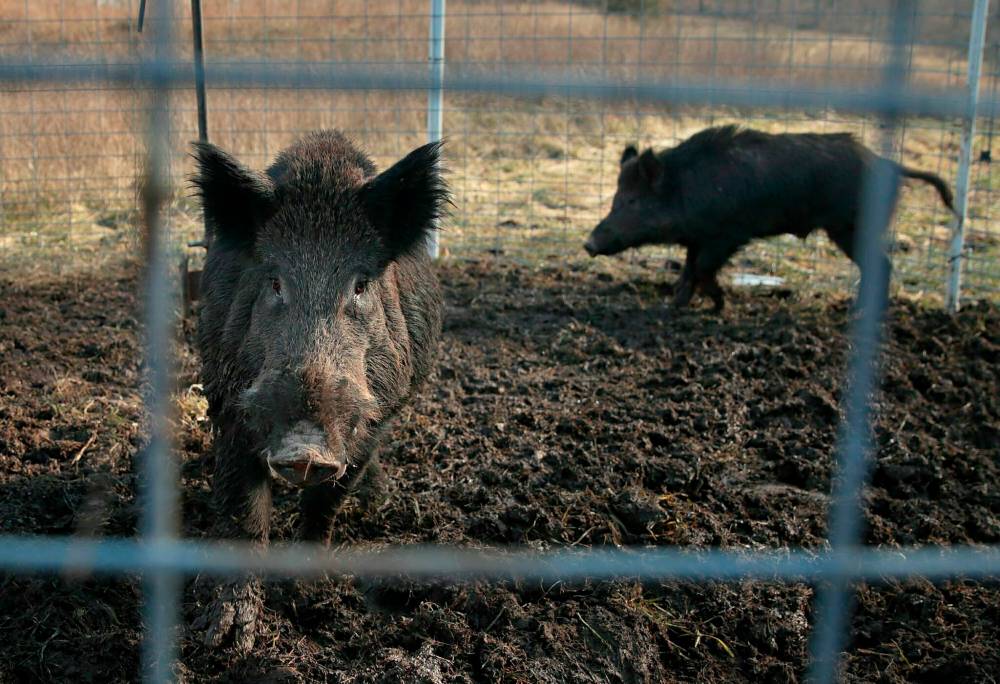Wild pigs in Prairies super-sized worry for ag sector
Advertisement
Read this article for free:
or
Already have an account? Log in here »
To continue reading, please subscribe:
Monthly Digital Subscription
$0 for the first 4 weeks*
- Enjoy unlimited reading on winnipegfreepress.com
- Read the E-Edition, our digital replica newspaper
- Access News Break, our award-winning app
- Play interactive puzzles
*No charge for 4 weeks then price increases to the regular rate of $19.00 plus GST every four weeks. Offer available to new and qualified returning subscribers only. Cancel any time.
Monthly Digital Subscription
$4.75/week*
- Enjoy unlimited reading on winnipegfreepress.com
- Read the E-Edition, our digital replica newspaper
- Access News Break, our award-winning app
- Play interactive puzzles
*Billed as $19 plus GST every four weeks. Cancel any time.
To continue reading, please subscribe:
Add Free Press access to your Brandon Sun subscription for only an additional
$1 for the first 4 weeks*
*Your next subscription payment will increase by $1.00 and you will be charged $16.99 plus GST for four weeks. After four weeks, your payment will increase to $23.99 plus GST every four weeks.
Read unlimited articles for free today:
or
Already have an account? Log in here »
Hey there, time traveller!
This article was published 25/11/2023 (709 days ago), so information in it may no longer be current.
As Canada’s largest hog-producing province, Manitoba is also this country’s largest exporter of live hogs, selling about 3.5 million young pigs to the U.S. feeder market annually.
However, these days there’s one hog export being attributed to Manitoba and its neighbouring provinces to the west that doesn’t make the official counts, but is nonetheless achieving an almost mythical reputation.
Major media outlets in the U.S. and Canada this week were buzzing with headlines like this one: “A population of hard-to-eradicate ‘super pigs’ in Canada is threatening to invade the U.S.”

The Associated Press story picked up by the likes of CBS, USA Today and the Los Angeles Times recites what is by now a familiar tale on the Prairies.
Farmers attempting to diversify by raising wild boars in the 1980s either accidentally or purposely set them free when markets tanked about 20 years ago. The story goes that at some point in their genetic journey learning how to survive through the harsh Canadian winters, these pigs crossed with their domestic cousins to create a “super” hybrid.
When a similar story was making the rounds last April, researchers with the Texas A&M Natural Resources Institute kiboshed the notion that the Canadian wild pigs are a genetically distinct super strain.
“Feral swine over 400 lbs. do occur, but they are rare in their population,” an article in the institute’s journal says, noting how big they grow appears more connected to how much they eat than to their DNA.
“Wild pigs expanding across Canada do not appear to be a new breed of wild pig, and while some individuals may be exceptionally large, they are no more ‘super’ than other wild pig populations already established across the world,” it says.
Dr. Wayne Lees, Manitoba’s former head veterinarian who now leads the team working to control wild pig populations, concurs. “They’re not a different genetic strain, but they are adapted,” he says, adding any pig roaming free is a concern.
Whatever their body scale, feral hogs are a super-sized worry for the agricultural sector. Nocturnal and wily, they are prolific breeders, wrecking crops, pastures and fences, and even attacking domestic stock in their search for food. They aren’t immune to charging at people either.
But it’s their potential to become disease carriers that keeps the livestock sector on high alert.
If the dreaded African Swine Fever ever made its way into Canada, these wild hogs could easily become super spreaders. They can also carry diseases such as brucellosis and tuberculosis, which are a problem in cattle.
If African Swine Fever surfaced in a hog barn, export demand would shut down as hard and fast as it did on the beef sector in 2003, when one Alberta cow was diagnosed with bovine spongiform encephalitis, otherwise known as Mad Cow Disease. It took a generation for the beef industry to recover. Some say it never has.
The impact on the pork industry would be more catastrophic. Whereas cattle producers who couldn’t sell their animals had the option of keeping them on pasture for longer, hog barns have no such capacity. Unsellable animals would be euthanized.
Even the potential puts a chill on industry investment at a time when global demand for pork is growing, according to a recent Canadian Agricultural Policy Institute report on the challenges facing Canada’s livestock sector.
Lees and his team are working hard to make sure that doesn’t happen — at least not because of wild pigs. Through federal-provincial and industry funded programs such as the “squeal on pigs” tip line for the public to report sightings, they work with landowners to set up bait stations and corrals to trap them. Last year, they recorded 127 sightings and captured 122.
They also do surveillance using trail cameras and will be doing thermal imaging by drone. Work is underway to develop a test that will detect the presence of pig DNA in water, so they know where to look.
He’s optimistic teamwork and perseverance will pay off.
If he’s right, the legendary wild pigs of the Prairies could one day become about as common as Sasquatches.
Laura Rance is executive editor, production content lead for Glacier FarmMedia. She can be reached at lrance@farmmedia.com

Laura Rance is editorial director at Farm Business Communications.
Our newsroom depends on a growing audience of readers to power our journalism. If you are not a paid reader, please consider becoming a subscriber.
Our newsroom depends on its audience of readers to power our journalism. Thank you for your support.



